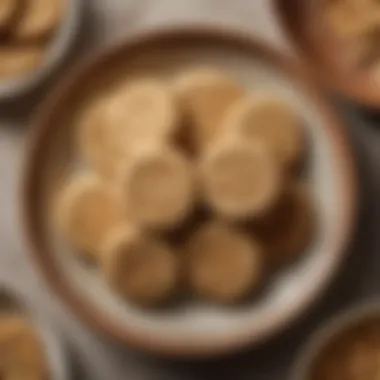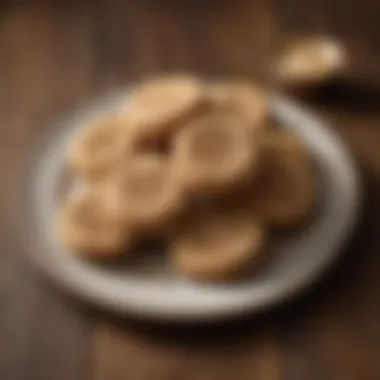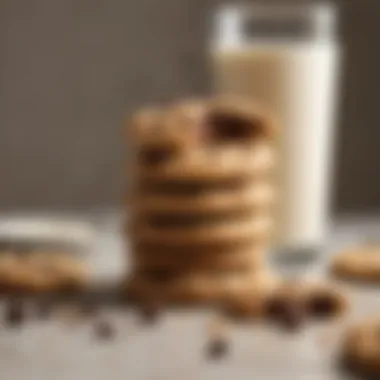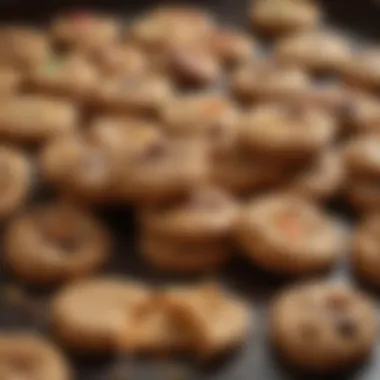Discover Three Unique Peanut Butter Cookie Recipes


Intro
Peanut butter cookies evoke nostalgia for many. With their crunchy exterior and soft inside, these cookies are perfect for all occasions. This article covers multiple important aspects of creating delicious peanut butter cookies, ranging from ingredient choices to various dietary options. The unique recipes highlighted cater to different tastes and needs. As a baker, understanding the delicate balance of ingredients can transform a simple cookie into an exceptional delight.
Ingredients Breakdown
Primary Ingredients
When discussing peanut butter cookies, a few crucial components stand out as essential. The foundation includes:
- Peanut Butter: The star ingredient. Choose creamy or crunchy based on personal preference.
- Sugar: Granulated sugar or brown sugar will enhance the overall taste.
- Eggs: Necessary for binding the ingredients together.
- Flour: All-purpose flour generally plays the supporting role.
- Baking Soda: Provides necessary rising action and textural contrast.
Optional Ingredients
Certain optional ingredients can elevate the cookie's taste and texture:
- Salt: Adds depth to sweetness. Always consider a pinch.
- Vanilla Extract: Offers subtle flavor enhancement.
- Chocolate Chips or Nuts: For added richness and texture.
Essential Kitchen Tools
Having the proper tools is crucial for efficient cookie making. Some essential items include:
- Mixing Bowls: Different sizes are beneficial for various steps.
- Baking Sheets: A flat, consistent surface for even baking.
- Measuring Cups and Spoons: Precision prevents inconsistencies.
- Spatula: Essential for shaping and transferring its unset cookie dough.
Step-by-Step Preparation
Prepping the Ingredients
Preparation sets the stage for successful baking. Start by measuring out all ingredients methodically. Any additional ingredients like chocolate chips need separate incorporation into the mix later.
- Organize your work area efficiently because consistency saves time.
- Make sure all ingredients are at room temperature to ensure smooth blending.
Cooking Techniques and Methods
The method of combining the ingredients can influence the cookie's final outcome. Start mixing the peanut butter and sugar until thoroughly combined. Following that:
- Add eggs and continue to mix well.
- Gradually incorporate the flour and baking soda until forming the dough.
Watch closely to prevent overmixing, which can lead secretly to tougher cookies.
Assembly and Presentation Tips
Generally, cookie shape speaks volumes about its personality. To form uniform cookies:
- Use a spoon or cookie scoop to ensure even sizes.
- Give each cookie enough space on the baking sheet for spreading.
- Optionally, sprinkle a dash of salt on top before baking to enhance flavor.
Dietary Considerations
Gluten-Free Options
A growing segment of bakers needs gluten-free alternatives. Options like almond flour or gluten-free baking blends can replace all-purpose flour without significant taste loss. Such substitutes give a delightful flavor profile to replacement cookies.
Vegetarian and Vegan Substitutes
Non-vegetarian bakers may need to use flaxseeds or apple sauce instead of eggs for a vegan solution. Nut butters and plant-based sugar further align with a broader dietary range.
Nutrition Facts & Nutritional Considerations
Understanding the nutritional aspect would aid for health-conscious individuals, e.g., using natural sweeteners will generaly decrease sugar content. Each ingredient carries calories, fats, and other essential nutrients, contributing to overall balance.
Variations and Customizations
Flavor Enhancements
Achieving varied flavors can invigorate the cookie experience. Consider adding:
- Cinnamon or nutmeg: For a warm, spicy touch
- White chocolate: Lends a rich sweetness
- Peanut brittle: For a richer crunch


Alternative Cooking Methods
Using different methods can result in distinct textures. Popular techniques include:
- Oven baking for a classic texture
- Microwave preparation for a quicker cooled-down treat.
Pairing Suggestions (Sides, Drinks, etc.
)
Pair nutty marvels with beverages to heighten pleasure:
- With coffee, enhances richness.
- With milk for a traditional nostalgic touch for all ages.
Common Common Questionss and Troubleshooting
Frequently Asked Questions
Common inquiries arise during peanut butter cookie creation:
- How do I fix dry cookies? Adjust humidity by adding milk.
- Why are cookies too flat? Ensure to cool before serving to recover shape.
Common Mistakes to Avoid
Mistakes often occur without discipline. Be sure to avoid over or under mixing, and ideally use soft butter for related tasks effectively.
Solutions to Potential Problems
To combat potential cookie failings:
- Monitor oven temperature with an accurate thermometer.
- Experiment with baking times. More often than not, cookies may require slight tweaks. Don’t hesitate to go off-script.
Ultimately, these distinct techniques and fundamentals present elaborate detail for every lover. Whether a beginner or a seasoned decorator in the kitchen, observing these methods will facilitate the creation of mouth-watering peanut butter cookies.
Foreword to Peanut Butter Cookies
Peanut butter cookies hold a special place in the hearts of many baking enthusiasts. They represent a blend of simplicity and rich flavor that appeals to a wide audience, from young children to adults seeking comfort food. Understanding what makes peanut butter cookies unique is essential for anyone looking to further their baking expertise. This subheading will dissect the foundational aspects that lend these cookies their beloved status while addressing practical considerations in baking.
Beneath their humble appearance lies an intricate balance of texture and taste. Peanut butter biased varies in richness and saltiness, compelling home bakers to pay close attention to ingredient choices. The flexibility of recipes allows for adaptations, appealing to diverse diets and preferences. Each batch tells a culinary story, reflecting the individual touch of its creator. Thus, exploring peanut butter cookies as a topic provides insights that can elevate one’s baking skills while celebrating the nostalgia often tied to these treats.
Historical Context of Peanut Butter Cookies
Peanut butter cookies have roots in the United States, tracing their history back to the late 19th century. During this time, peanut butter began to gain popularity, thanks partly to its introduction at the St. Louis World's Fair in 1904. At this event, various food innovations instigated interest in diverse culinary uses of peanut products.
The original recipes thrilled bakers with their simplicity and delightful taste. Eventually, peanut butter technology evolved, making the spread easily accessible, thus leading to more recipe experimentation. With the rise of homemaking traditions, peanut butter cookies found their way into countless households, underscoring their significance as a comfort dessert. Going through different eras, these cookies soft pplayed a role in shaping American dessert culture, blending tradition with innovation.
Moreover, these cookies are often featured in various regional and cultural celebrations, making them more than just a treat; they symbolize a sense of community and home. Studying their historical evolution adds depth to our understanding of how they have transitioned through both time and societal preferences.
Nutritional Profile of Peanut Butter
Peanut butter is not just a flavor agent; it also contributes substantial nutritional benefits when included in recipes. While it enhances taste, its qualities influence the texture and nutritional value of cookies significantly. Rich in proteins, healthy fats, and essential vitamins, peanut butter supports various dietary needs, becoming a staple for many health-conscious cooks.
On average, two tablespoons of peanut butter contain:
- About 180 calories
- 8 grams of protein
- 16 grams of fat, with a good portion contributed by heart-healthy unsaturated fats
- Various vitamins and minerals such as magnesium, phosphorus, and vitamin E
These nutritional profiles factor heavily into the dietary conversations surrounding dessert. Regardless of dietary considerations, cookies baked with peanut butter can align pretty well with moderate indulgence.
It is important to note, however, that moderation is key. Those with nut allergies need to avoid peanut products entirely; thus, understanding adequate replacements can help widen the appeal of such recipes. By honing in on peanut butter's nutritional attributes and making clever substitutions, bakers can cater to diverse audiences, ensuring everyone enjoys the beloved comfort of peanut butter cookies.
Classic Peanut Butter Cookie Recipe
The classic peanut butter cookie is not just any dessert; it is a staple in many households. This recipe showcases traditional flavors and texture, allowing both novice and skilled bakers to create delicious cookies that stand the test of time. The significance of this recipe goes beyond taste, as it offers a basic foundation that can easily be modified to suit different preferences.
Essential Ingredients
Peanut Butter options


When it comes to choosing peanut butter, your selection can greatly influence the final product. There are various options like creamy, crunchy, and natural. Creamy peanut butter blends easily and results in smooth, uniform cookies. In contrast, crunchy peanut butter adds delightful texture, creating additional nuttiness in each bite. Natural varieties are typically free from added sugars or oils. Choosing natural peanut butter may lead to healthier cookies but can produce a slightly more crumbly texture due to the absence of stabilizers.
Sugar types
Sugar plays a key role in providing sweetness, but its type also affects the dough characteristics. Using white granulated sugar can result in a crisp texture, while brown sugar contributes to a chewier consistency and a rich caramel flavor. Mixing both can yield a balanced outcome. However, substitutes like coconut sugar or honey can affect moisture levels, leading to inconsistency in baking. Therefore, understanding sugar types helps in manipulating flavor and texture beneficially.
Egg role in baking
Eggs are crucial in many baking recipes, including peanut butter cookies. They act as a binding agent, ensuring all ingredients meld together cohesively. Eggs also provide moisture, which is essential for cookie texture. When you use eggs, the result is a lustrous finish and a soft interior. However, if someone avoids eggs, using a substitute like flaxseed or applesauce is viable. Still, this may alter the traditional texture one might expect from classic cookies.
Preparation Instructions
Mixing the ingredients
The process of mixing ingredients lays the groundwork for your cookies. When combined properly, the peanut butter, sugars, and eggs harmonize to create a uniform batter. Mixing excessively can introduce too much air, leading to a puffy cookie, while under-mixing may result in uneven distribution of flavors. Taking care during this step makes a significant impact on the end product.
Shaping the cookies
Shaping the cookies is both an art and a science. Using a cookie scoop allows for uniformity in size, which promotes even baking. While rolling them into balls, pressing flat creates that signature peanut butter cookie with fork markings. Shape impacts not just presentation but also baking time and texture. Consistent shapes yield consistent baking. Deviations in size could lead to unwanted variances in the final product.
Baking time and temperature
Baking properly involves precision. For most classic peanut butter cookie recipes, a range of 350 to 375 degrees Fahrenheit is efficient. This facilitates even baking without burning the bottoms. Overbaking results in a dry cookie, while underbaking renders a raw center. Thus, carefully monitoring baking time while assessing them visually can ensure optimal texture and flavor satisfaction.
Tips for Achieving the Ideal Texture
Creating the perfect cookie texture hinges on several factors. Consider chilling the dough for at least 30 minutes. This prevents spreading during baking and helps attain that desired thick appearance. Also, let the cookies rest post-baking, allowing them to firm up before transferring to a cooling rack. Implementing gentle handling ensures cookies do not collapse. Alternatively, avoiding over-mixing can keep cookies tender, preserving soft centers. Follow these practices to craft reliable classic peanut butter cookies.
Chocolate Chip Peanut Butter Cookies
Chocolate chip peanut butter cookies are an adventurous fusion of beloved flavors. Their significance lies not only in their taste but in their capacity to bridge the worlds of classic cookies and innovative baking. This subclass of peanut butter cookies appeals to myriad palates, making it an extraordinary choice for gatherings or simple everyday indulgence.
Recipe Variations
Choosing the right chocolate
The choice of chocolate greatly affects the character of these cookies. Using semi-sweet chocolate chips creates a balanced flavor profile, complementing the nuttiness of the peanut butter. Other options, such as dark chocolate or even milk chocolate, can be chosen based on personal preference and mood.
For example, dark chocolate brings a more intense flavor that can contrast well with the sweetness of the cookie base. Its boldness results in a more adventurous dessert. However, if one prefers something milder, milk chocolate may feel more comforting and familiar. Each variation presents opportunities to tailor the cookie experience.
Adjusting sweetness
Adjusting sweetness can play a vital role in curating the desired experience of chocolate chip peanut butter cookies. Many recipes default to brown sugar, yielding softer and chewier textures because of the moisture content in these sugars. One can modify the sweetness level by increasing or decreasing the sugar, or opting for alternative sweeteners like agave or stevia.
While reducing sugar may create a healthier option, careful consideration of flavor is key. Too little sweetness may overwhelm the taste, causing unsettling blandness. Thus, maintaining balance is essential.
Gluten-free options
In today’s diverse dietary landscape, gluten-free recipes are becoming increasingly important. Selecting the realized cassava or almond flour enables the same delightful peanut butter cookie texture without gluten. That not only accommodates those with gluten intolerance but also introduces new appeal.
While gluten-based flour provides structure, using alternatives strategically can enhance flavor too. Almond flour, for instance, imparts a unique nuttiness that harmonizes with the peanut butter. However, variations exist, and they require baking adjustments—including additional binds like xanthan gum— for achieving the desired cookie consistency.
Preparation Steps
Having assembled the seemingly straightforward introduction to the concept of creating chocolate chip peanut butter cookies, the preparation starts with gathering essential elements.
- Combine dry and wet ingredients: Start by mixing flour, baking powder, and salt in one bowl. In another bowl, cream together peanut butter, sugars, and egg.
- εntegration of chocolate chips: Add chocolate chips into the wet mixture and stir gently to maintain the shape of chips during baking.
- Combine mixtures: Gradually add the dry ingredients into the wet mix until fully incorporated, careful to minimize over-mixing.
- Chilling dough: While optional, refrigerating the dough for around 30 minutes can stabilise the cookie before baking, providing better shaping and height upon baking.
Baking Techniques
Achieving optimum results from chocolate chip peanut butter cookie dough often hinges on baking techniques. Though the components merge perfectly, how they interact in the oven must not be underestimated.
- Monitor temperature: Preheating the oven to the correct temperature prevents unnecessary dissober l handling of fats, ensuring nothing collapses down while it maкониться.
- Use parchment paper or silicone mats: These surfaces create even baking conditions while promoting easier cookie remeval.
- Keep a watchful eye during baking: Cookies that may seem uniform while in the oven might earlier than evicted, so wrapping a timer is efficient. When edges appear golden, they're likely closer to finished.
The balance of peanut butter and chocolate earns chocolate chip peanut butter cookies a deserved place in culinary exploration, allowing bakers the flexibility to experiment yet contributing comforting qualities. Understanding choices among variations and methods ensure dynamic, flavorful outcomes in these carbs. Each step cultivates deeper baking skills and hunger for creativity, making it clear why these cookies intrigued all ages.
Health-Conscious Peanut Butter Cookies


Health-conscious peanut butter cookies represent an important aspect of baking that caters to the ever-evolving preferences of today’s consumers. With increasing awareness of dietary needs and nutrition, many people seek to enjoy classic treats while making healthier choices. These alternatives allow for indulgence without extensive guilt. Emphasizing health consciousness also aligns with lifestyles focused on well-being without sacrificing flavor and enjoyment.
Substituting Ingredients for Health
Using Natural Sweeteners
Using natural sweeteners like honey, maple syrup, or agave nectar can significantly change how peanut butter cookies are perceived in terms of health. They provide sweetness without relying predominantly on refined sugars. One key characteristic of natural sweeteners is that they often come with added minerals and antioxidants, which are absent in conventional sugar. This makes them a beneficial choice for those who focus on more holistic ingredients. However, one unique feature of natural sweeteners is their ability to retain moisture in cookies, potentially leading to a softer texture. But it is essential to consider that some people might need to adjust the amount of sweeteners used, as they can vary widely in sweetness intensity compared to sold sugar types.
Incorporating Whole Grains
Incorporating whole grains into cookie recipes can enhance nutritional profile greatly. Whole grains, such as whole wheat flour or oats, contain essential fiber and can support digestive health. This element makes whole grains a popular choice among health-focused baking enthusiasts. A unique feature of whole grains is their higher nutrient content compared to refined alternatives. Yet, care should be taken, as substituting all-purpose flour with whole grains can lead to denser cookies if not mixed properly. Balancing the ratios may be necessary to achieve a palatable combination.
Reducing Fats
Reducing fats in peanut butter cookies calls attention to the need for conscious calorie management without compromising taste. Choosing lower-fat peanut butter options or integrating alternatives like pureed fruits can lead to lighter cookies. The main benefit of reducing fats lies in the overall decrease in calorie content, making these cookies appealing to many health-conscious individuals. An essential aspect to consider is texture; replacing high-fat butter or peanut butter might results in a different consistency. Therefore, finding a complementary balance is crucial to maintaining the cookie experience while promoting healthier baking practices.
Preparation Process
The preparation process for health-conscious peanut butter cookies involves methodical steps, ensuring that each ingredient serves its unique purpose. Begin by gathering clean, quality ingredients. Mix natural sweeteners, such as honey with any expected dry ingredients. Incorporate whole grain options gradually while sculpting the desired cookie dough. Critical attention should now be paid to cooling times, which could impact the final texture of cookies drastically. Ideal results from mixing and baking can lead not only to unforgettable flavors but also promote better eating habits when shared.
Evaluating Flavor and Texture Adjustments
Evaluating flavor and texture adjustments hinges on mindful practices of balancing health and indulgence. As flavors intensify naturally through ingredient substitutes, the combination may yield unique profiles. Testing small batches before finalizing the update is often beneficial to assess changing textures and taste nuances. Slight modifications, such as adjusting moisture from natural sweeteners or introducing additional spices may enhance the final product without complicating health objectives. Maintaining clear copies of baking experiments furthers understanding, allowing bakers to refine and replicate their successes uniquely while contributing positively to a healthier baking environment.
Common Issues and Troubleshooting
When baking, understanding common issues and how to troubleshoot them is essential to mastering the art of peanut butter cookie making. Knowing what might go wrong and how to correct it not only saves time but also ensures a better end product. Whether one is a novice baker or a seasoned kitchen veteran, encountering challenges is a part of the learning process. This section aims to explain specific challenges in peanut butter cookie baking and provide practical solutions to enhance your baking experience.
Overbaking and Underbaking
Achieving the perfect texture in peanut butter cookies often comes down to the delicate balance of baking time. Overbaking can lead to cookies that are hard and dry, while underbaking can result in a doughy or soft center that might not hold together.
Here are important points to consider when it comes to overcoming this challenge:
- Use a timer: Always use a timer while baking. Cookies often have a narrow window of time for the best texture.
- Visual cues: Look for the edges of the cookies to become golden brown. The center might look slightly underbaked, but as they cool, they will firm up.
- Cooling time: Allow the cookies to cool on the baking sheet for a few minutes before transferring them to a wire rack. This helps in both texture and appearance.
Baker's tip: If the cookies are still too soft, you can place them back in the oven for a short additional amount of time, but be sure to watch them closely.
Baking cookies is very precise. Even a minute can make a huge differce in texture!
Ingredient Substitution Challenges
In today's health-conscious world, many bakers wish to alter their recipes to suit specific dietary needs or preferences. However, substituting certain ingredients in peanut butter cookie recipes can lead to unexpected results. Identifying suitable replacements and understanding their impact on texture and flavor are key.
Consider the following:
- Peanut Butter Variations: Using natural peanut butters without emulsifiers can cause a change in moisture content, affecting cookie density. Test with brands known for consistency.
- Sugar Alternatives: While switching to alternatives like honey or agave syrup can reduce calories, they differ in sweetness and moisture levels, requiring adjustments to other ingredients.
- Flour Types: If opting for gluten-free alternatives, be aware that they often absorb moisture differently. Experimentation is often necessary to achieve the right crumb.
Keep this in mind: Substituting too many ingredients at once can complicate outcomes. Stick to one at a time, reflecting on performance with each batch.
Culmination and Final Thoughts
In this exploration of peanut butter cookies, we review the significance of the recipes and their distinctive features. Peanut butter cookies offer a range of flavors and textures, making them an appealing choice for various preferences. Each recipe discussed brings unique elements to the table. Emphasizing the ingredient combinations, their roles, and the baking techniques enrich the overall baking experience.
Not only do these recipes cater to different taste preferences, they also allow for personal modifications. Flexibility in the choices, from health-conscious substitutions to traditional methods, makes baking more accessible. Understanding the implications of ingredient selections ensures a deeper appreciation of peanut butter cookies in both flavor and dietary aspects.
Furthermore, we illustrate the common troubles encountered when baking peanut butter cookies. By learning to distinguish between overbaking and underbaking, readers can achieve the greatest results. Through careful attention to details, it is possible to bake cookies that not only taste extraordinary but also have the perfect texture.
"Baking is not just a skill, but a creative journey that encourages exploration through flavors and textures."
Baking peanut butter cookies serves as a conduit for sharing experiences and building connections among food enthusiasts. Each bite can spark memories or inspire new creations, making cookies more than just a treat. Therefore, it is fitting to encapsulate the journey of this article focusing on opportunities for culinary innovation and exploration.
Recap of Key Points
- Diverse Recipes: The article reviewed classic peanut butter cookie recipes, fun variations like chocolate chip, and healthy substitutes.
- Importance of Ingredients: Key focus was on assembling the right ingredients to contribute to both flavor and texture.
- Troubleshooting Common Issues: It highlighted overbaking and underbaking, addressing the pitfalls to avoid.
- Culinary Creativity: Modification of recipes is always encouraged, enhancing personal style and preference.
Encouragement for Culinary Exploration
Encouraging culinary exploration pushes both beginner and experienced bakers to engage in creativity. Each recipe can act as a basic concept, open for adjustments. Individuals can experiment with adding distinct flavors like vanilla or even spices. Testing combinations and variations can lead to discoveries that elevate a simple peanut butter cookie recipe.
Furthermore, experimenting with different types of nuts, sizes, or shapes generates excitement in the kitchen. Creating unique baked goods enhances one's baking skills and leads to shareable outcomes while fostering conversation. Inviting friends or family into the baking process creates connections through bonds of teamwork and collaboration.
Celebrating your own culinary journey whilst navigating through these three recipes can enrich your experience. Food is ultimately a unifying force, and peanut butter cookies hold a special place in many hearts. Let each experiment inspire you to continue your exploration in the broad world of baking.







